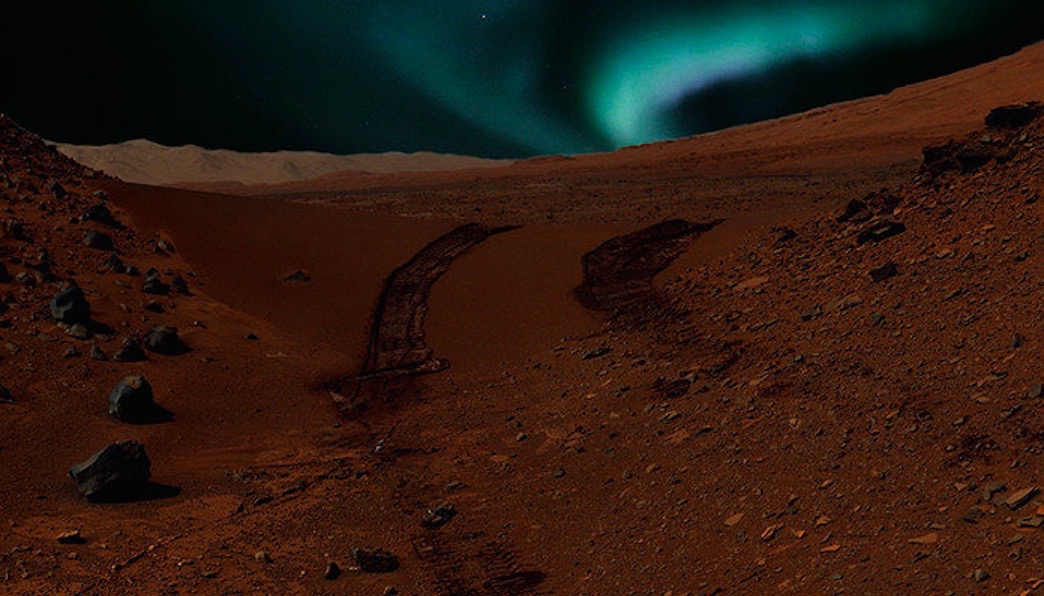Gorgeous Auroras Could Light Up Entire Martian Sky

The first astronauts to set foot on Mars may be in for a spectacular sight — the entire night sky filled with glowing auroras.
Researchers working on NASA's Mars Atmosphere and Volatile Evolution (MAVEN) mission hosted a news conference this afternoon (Nov. 5) to discuss the orbiter's observations about the Red Planet's loss of atmosphere due to solar wind, and they also shared some details about MAVEN's measurements of Mars auroras.
"A new kind of aurora was observed at Mars that frankly surprised us, and this was aurorae in a part of the atmosphere that is above regions that don't have a magnetic field at all," Dave Brain, MAVEN co-investigator and researcher at the University of Colorado Boulder's Laboratory for Atmospheric and Space Physics (LASP), said during the news conference. "It's strange to think about, based on our personal experience, aurorae that don't take place in magnetic fields." [Amazing Auroras: Breathtaking Northern Lights Photos of 2015]
MAVEN detected these auroras using an instrument that observes ultraviolet light, which our eyes cannot detect. But modeling work suggests that the Martian phenomena may also be visible to the naked eye, Brain said.
"If you're standing on the night side of Mars in a place where there's no light pollution, and looking up at the sky, you could see the whole sky light up at one of these events," Brain said. "It would be magnificent."
Bright enough displays of this kind could possibly shine in green, red or blue light, aurora study lead author Nick Schneider, also of LASP, told Space.com via email.
Earth's auroras are focused around the North and South Poles. The Earth's strong magnetic field deflects the charged particles streaming from the sun toward the planet's magnetic poles, creating a glowing, rippling light display.
Get the Space.com Newsletter
Breaking space news, the latest updates on rocket launches, skywatching events and more!
Mars, on the other hand, lacks a global magnetic field. That's bad news for protection against harsh radiation, but it means solar particles can make an impact across the entire sky.
MAVEN has detected just a few large-scale aurora events since starting its science mission in November 2014. One event occurred in a 3- to 5-day stretch around Christmas in 2014 (which is why researchers termed the display the "Christmas Lights"), and another took place this past March.
The orbiter has also detected very weak, quickly dissipating auroras caused by small-scale magnetic fluctuations on the planet, researchers said.
Email Sarah Lewin at slewin@space.com or follow her @SarahExplains. Follow us @Spacedotcom, Facebook and Google+. Original article on Space.com.
Join our Space Forums to keep talking space on the latest missions, night sky and more! And if you have a news tip, correction or comment, let us know at: community@space.com.

Sarah Lewin started writing for Space.com in June of 2015 as a Staff Writer and became Associate Editor in 2019 . Her work has been featured by Scientific American, IEEE Spectrum, Quanta Magazine, Wired, The Scientist, Science Friday and WGBH's Inside NOVA. Sarah has an MA from NYU's Science, Health and Environmental Reporting Program and an AB in mathematics from Brown University. When not writing, reading or thinking about space, Sarah enjoys musical theatre and mathematical papercraft. She is currently Assistant News Editor at Scientific American. You can follow her on Twitter @SarahExplains.









